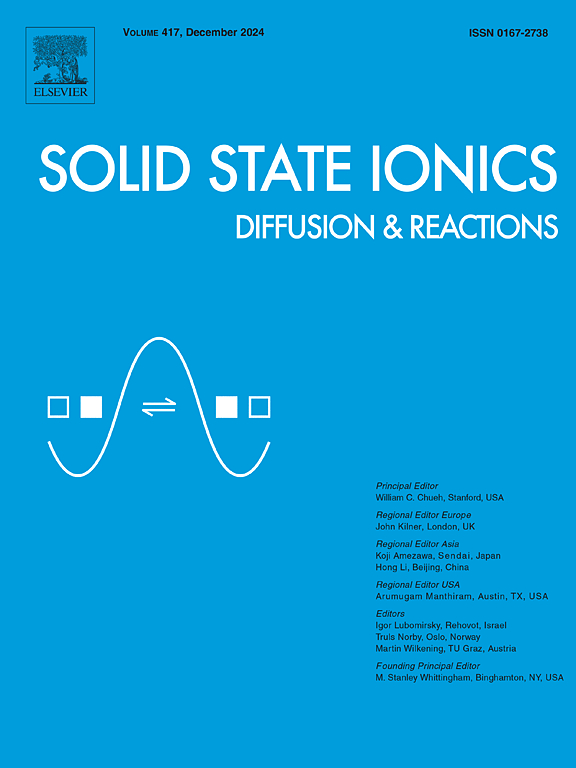磷和氟对硅酸氧磷灰石镧烧结性能、c轴取向和离子电导率的影响
IF 3.3
4区 材料科学
Q3 CHEMISTRY, PHYSICAL
引用次数: 0
摘要
降低固体氧化物电池(soc)的工作温度是其广泛应用的关键挑战。硅酸镧氧磷灰石(LSO)具有沿c轴方向的高离子导电性,是一种很有前途的电解质材料。LSO的低烧结性和对c轴取向控制的要求阻碍了其应用。在本研究中,我们研究了磷和氟作为烧结掺杂剂对LSO烧结性能、微观结构和离子电导率的影响。在烧结温度为1550℃(含氟)和1700℃(含磷)的条件下,成功制备了相对密度超过95%的致密LSO球团。添加磷的LSO表现出沿C轴方向的柱状晶粒生长特征,与氧化钇稳定的氧化锆相比,在约700°C下离子电导率更高。这些结果为降低soc的工作温度提供了有价值的指导。本文章由计算机程序翻译,如有差异,请以英文原文为准。
Effect of phosphorus and fluorine on sinterability, c-axis orientation, and ionic conductivity of lanthanum silicate oxyapatite
Lowering the operating temperature of solid oxide cells (SOCs) is a key challenge for their widespread use. Lanthanum silicate oxyapatite (LSO) is a promising electrolyte material owing to its high ionic conductivity along the c-axis direction. The application of LSO is hindered by its low sinterability and the requirement for controlling c-axis orientation. In this study, we investigated the effects of phosphorus and fluorine as sintering dopants on the sinterability, microstructure, and ionic conductivity of LSO. Dense LSO pellets with a relative density of over 95 % were successfully fabricated at sintering temperatures of 1550 °C for fluorine-added LSO and 1700 °C for phosphorus-added LSO. Phosphorus-added LSO exhibited characteristic columnar grain growth along the c-axis direction, resulting in higher ionic conductivities under approximately 700 °C compared with that of yttria-stabilized zirconia. These results provide valuable guidance for lowering the operating temperatures of SOCs.
求助全文
通过发布文献求助,成功后即可免费获取论文全文。
去求助
来源期刊

Solid State Ionics
物理-物理:凝聚态物理
CiteScore
6.10
自引率
3.10%
发文量
152
审稿时长
58 days
期刊介绍:
This interdisciplinary journal is devoted to the physics, chemistry and materials science of diffusion, mass transport, and reactivity of solids. The major part of each issue is devoted to articles on:
(i) physics and chemistry of defects in solids;
(ii) reactions in and on solids, e.g. intercalation, corrosion, oxidation, sintering;
(iii) ion transport measurements, mechanisms and theory;
(iv) solid state electrochemistry;
(v) ionically-electronically mixed conducting solids.
Related technological applications are also included, provided their characteristics are interpreted in terms of the basic solid state properties.
Review papers and relevant symposium proceedings are welcome.
 求助内容:
求助内容: 应助结果提醒方式:
应助结果提醒方式:


